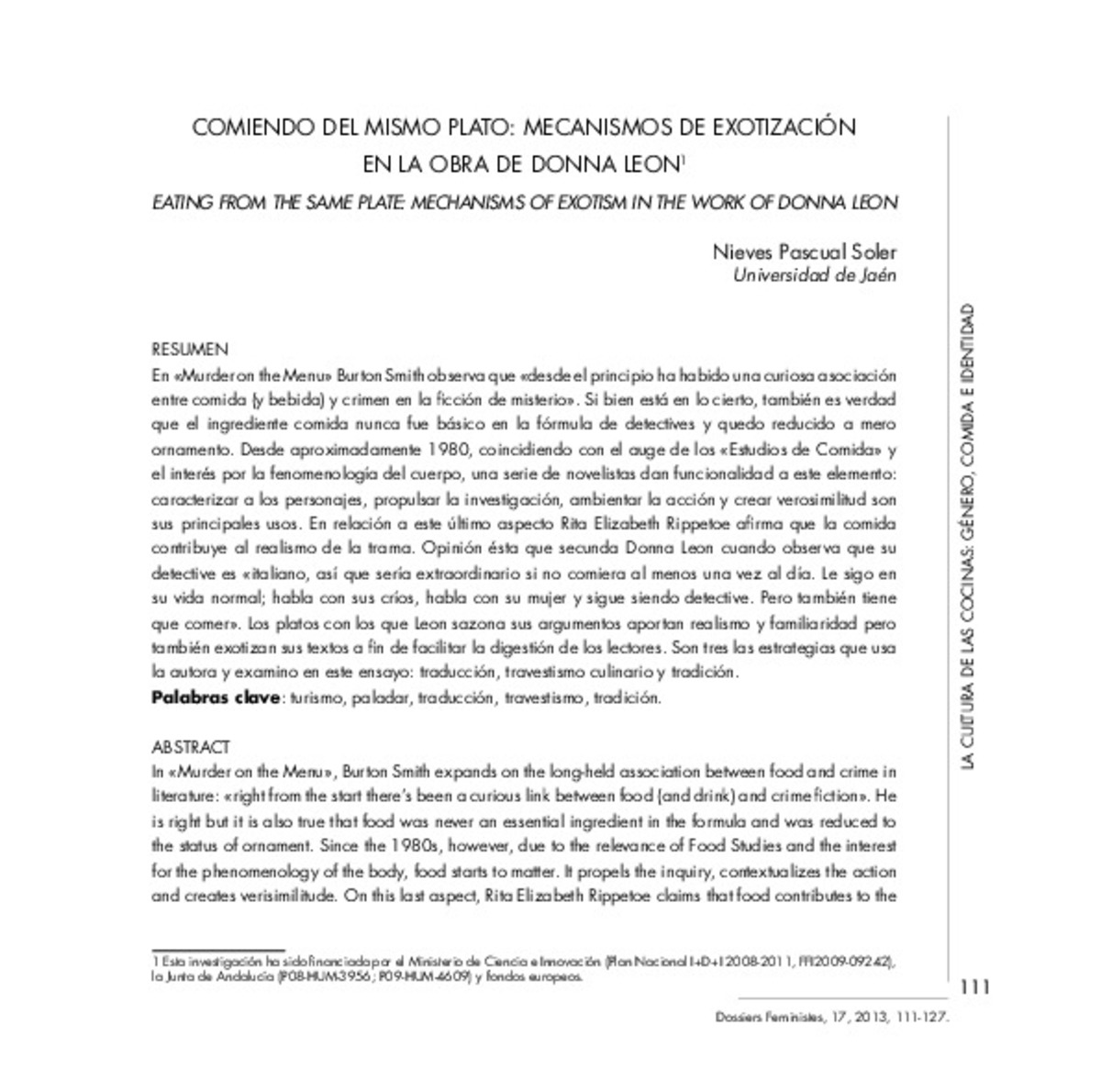Mostrar el registro sencillo del ítem
COMIENDO DEL MISMO PLATO: MECANISMOS DE EXOTIZACIÓN EN LA OBRA DE DONNA LEON
| dc.contributor.author | Pascual Soler, Nieves | |
| dc.date.accessioned | 2015-11-18T11:03:44Z | |
| dc.date.available | 2015-11-18T11:03:44Z | |
| dc.date.issued | 2013 | |
| dc.identifier.issn | 1139-1219 | |
| dc.identifier.issn | 2340-4930 | |
| dc.identifier.uri | http://hdl.handle.net/10234/140666 | |
| dc.description.abstract | En «Murder on the Menu» Burton Smith observa que «desde el principio ha habido una curiosa asociación entre comida (y bebida) y crimen en la ficción de misterio». Si bien está en lo cierto, también es verdad que el ingrediente comida nunca fue básico en la fórmula de detectives y quedo reducido a mero ornamento. Desde aproximadamente 1980, coincidiendo con el auge de los «Estudios de Comida» y el interés por la fenomenología del cuerpo, una serie de novelistas dan funcionalidad a este elemento: caracterizar a los personajes, propulsar la investigación, ambientar la acción y crear verosimilitud son sus principales usos. En relación a este último aspecto Rita Elizabeth Rippetoe afirma que la comida contribuye al realismo de la trama. Opinión ésta que secunda Donna Leon cuando observa que su detective es «italiano, así que sería extraordinario si no comiera al menos una vez al día. Le sigo en su vida normal; habla con sus críos, habla con su mujer y sigue siendo detective. Pero también tiene que comer». Los platos con los que Leon sazona sus argumentos aportan realismo y familiaridad pero también exotizan sus textos a fin de facilitar la digestión de los lectores. Son tres las estrategias que usa la autora y examino en este ensayo: traducción, travestismo culinario y tradición. | ca_CA |
| dc.description.abstract | In «Murder on the Menu», Burton Smith expands on the long-held association between food and crime in literature: «right from the start there’s been a curious link between food (and drink) and crime fiction». He is right but it is also true that food was never an essential ingredient in the formula and was reduced to the status of ornament. Since the 1980s, however, due to the relevance of Food Studies and the interest for the phenomenology of the body, food starts to matter. It propels the inquiry, contextualizes the action and creates verisimilitude. On this last aspect, Rita Elizabeth Rippetoe claims that food contributes to the realism of the mystery plot. Her opinion is embraced by Donna Leon when she writes that her detective is «an Italian, so that it would be extraordinary if he did not eat at least once a day. I follow him through his normal life; he talks to his kids, he talks to his wife, he goes about being a detective. But he also has to eat». If eating cultivates a sense of ordinariness it also donates a sense of extraordinariness to the text. Three are the strategies the author uses to create an air of exotic verisimilitude: Translation, transvestism and tradition. | ca_CA |
| dc.format.mimetype | application/pdf | ca_CA |
| dc.language.iso | spa | ca_CA |
| dc.publisher | Universitat Jaume I. Institut Universitari d'Estudis Feministes i de Gènere | ca_CA |
| dc.relation.isPartOf | Dossiers Feministes, núm. 17 | ca_CA |
| dc.rights.uri | http://rightsstatements.org/vocab/CNE/1.0/ | * |
| dc.subject | turismo | ca_CA |
| dc.subject | paladar | ca_CA |
| dc.subject | traducción | ca_CA |
| dc.subject | travestismo | ca_CA |
| dc.subject | tradición | ca_CA |
| dc.subject | tourism | ca_CA |
| dc.subject | palate | ca_CA |
| dc.subject | translation | ca_CA |
| dc.subject | transvestism | ca_CA |
| dc.subject | tradition | ca_CA |
| dc.subject.other | Dones -- Revistes | ca_CA |
| dc.subject.other | Feminisme -- Revistes | ca_CA |
| dc.title | COMIENDO DEL MISMO PLATO: MECANISMOS DE EXOTIZACIÓN EN LA OBRA DE DONNA LEON | ca_CA |
| dc.title.alternative | EATING FROM THE SAME PLATE: MECHANISMS OF EXOTISM IN THE WORK OF DONNA LEON | ca_CA |
| dc.type | info:eu-repo/semantics/article | ca_CA |
| dc.rights.accessRights | info:eu-repo/semantics/openAccess | ca_CA |
| dc.relation.publisherVersion | http://www.e-revistes.uji.es/index.php/dossiers/article/view/1214/1088 | ca_CA |







